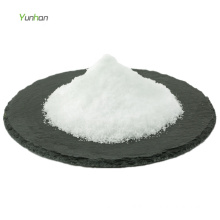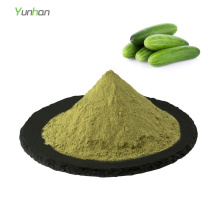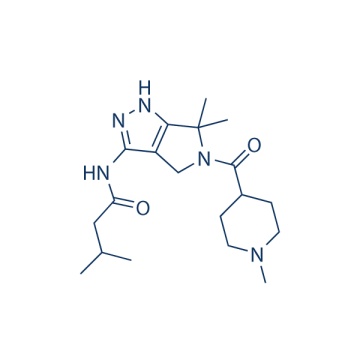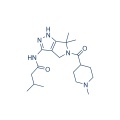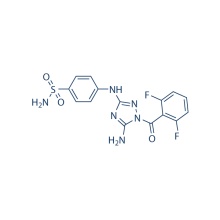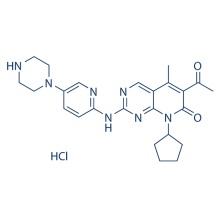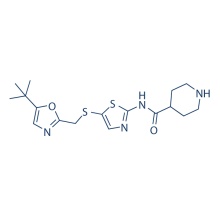PHA-793887 718630-59-2
Product Description
.cp_wz table {border-top: 1px solid #ccc;border-left:1px solid #ccc; } .cp_wz table td{border-right: 1px solid #ccc; border-bottom: 1px solid #ccc; padding: 5px 0px 0px 5px;} .cp_wz table th {border-right: 1px solid #ccc;border-bottom: 1px solid #ccc; padding: 5px 0px 0px 5px;}
Molecular Weight:
361.48 PHA-793887 is a novel and Potent Inhibitor of CDK2, CDK5 and CDK7 with IC50 of 8 nM, 5 nM and 10 nM. It is greater than 6-fold more selective for CDK2, 5, and 7 than CDK1, 4, and 9. Phase 1.
Biological Activity
PHA-793887 has low activity against CDK1, CDK4, CDK9 and GSK3β with IC50
of 60 nM, 62 nM, 138 nM and 79 nM, respectively. PHA-793887 inhibits
cell proliferation of many tumor cell lines, including A2780, HCT-116,
COLO-205, C-433, DU-145, A375, PC3, MCF-7, and BX-PC3, with IC50 of 88
nM–3.4 μM. PHA-793887 (1 μM) shows a decrease in the S phase, a
subsequent increase of the G1 phase and a slight accumulation of G2/M
phase in A2780 cells. PHA-793887 (3 μM) significantly increases G2/M
phase and reduces DNA synthsis.
PHA-793887 is cytotoxic for leukemic
cell lines, including K562, KU812, KCL22, and TOM1, with IC50 of 0.3–7
μM, but it is not cytotoxic for normal unstimulated peripheral blood
mononuclear cells or CD34+ hematopoietic stem cells. In colony assays,
PHA-793887 shows very high activity against leukemia cell lines with
IC50 less than 0.1 μM. PHA-793887 induces cell-cycle arrest, inhibits Rb
and nucleophosmin phosphorylation, and modulates cyclin E and cdc6
expression at 0.2−1 μM and induces Apoptosis at 5 μM.
PHA-793887 (10–30 mg/kg) shows good efficacy in the human ovarian A2780,
colon HCT-116, and pancreatic BX-PC3 carcinoma xenograft models.
PHA-793887 (20 mg/kg) is effective in xenograft models of K562 and HL60
cells, primary leukemic disseminated model, and a high-burden
disseminated ALL-2 model derived from a relapsed Philadelphia-positive
acute lymphoid leukemia patient.
Protocol(Only for Reference)
Kinase Assay: [3]
Cell Assay: [1]
Animal Study: [1]
Conversion of different model animals based on BSA (Value based on data from FDA Draft Guidelines)
For example, to modify the dose of resveratrol used for a mouse (22.4 mg/kg) to a dose based on the BSA for a rat, multiply 22.4 mg/kg by the Km factor for a mouse and then divide by the Km factor for a rat. This calculation results in a rat equivalent dose for resveratrol of 11.2 mg/kg.
Chemical Information
Molarity Calculator
Dilution Calculator
Molecular Weight Calculator
Contact us if you need more details on 718630-59-2. We are ready to answer your questions on packaging, logistics, certification or any other aspects about PHA-793887 718630-59-2、718630-59-2 PHA-793887. If these products fail to match your need, please contact us and we would like to provide relevant information.
Molecular Weight:
361.48 PHA-793887 is a novel and Potent Inhibitor of CDK2, CDK5 and CDK7 with IC50 of 8 nM, 5 nM and 10 nM. It is greater than 6-fold more selective for CDK2, 5, and 7 than CDK1, 4, and 9. Phase 1.
Biological Activity
PHA-793887 has low activity against CDK1, CDK4, CDK9 and GSK3β with IC50
of 60 nM, 62 nM, 138 nM and 79 nM, respectively. PHA-793887 inhibits
cell proliferation of many tumor cell lines, including A2780, HCT-116,
COLO-205, C-433, DU-145, A375, PC3, MCF-7, and BX-PC3, with IC50 of 88
nM–3.4 μM. PHA-793887 (1 μM) shows a decrease in the S phase, a
subsequent increase of the G1 phase and a slight accumulation of G2/M
phase in A2780 cells. PHA-793887 (3 μM) significantly increases G2/M
phase and reduces DNA synthsis.
PHA-793887 is cytotoxic for leukemic
cell lines, including K562, KU812, KCL22, and TOM1, with IC50 of 0.3–7
μM, but it is not cytotoxic for normal unstimulated peripheral blood
mononuclear cells or CD34+ hematopoietic stem cells. In colony assays,
PHA-793887 shows very high activity against leukemia cell lines with
IC50 less than 0.1 μM. PHA-793887 induces cell-cycle arrest, inhibits Rb
and nucleophosmin phosphorylation, and modulates cyclin E and cdc6
expression at 0.2−1 μM and induces Apoptosis at 5 μM.
PHA-793887 (10–30 mg/kg) shows good efficacy in the human ovarian A2780,
colon HCT-116, and pancreatic BX-PC3 carcinoma xenograft models.
PHA-793887 (20 mg/kg) is effective in xenograft models of K562 and HL60
cells, primary leukemic disseminated model, and a high-burden
disseminated ALL-2 model derived from a relapsed Philadelphia-positive
acute lymphoid leukemia patient.
Protocol(Only for Reference)
Kinase Assay: [3]
| CDK Kinase Assay | The biochemical activity of compounds is determined by incubation with specific enzymes and substrates, followed by quantitation of the phosphorylated product. PHA-793887 (1.5 nM–10 μM) is incubated for 30−90 min at room temperature in the presence of ATP/33P-γ-ATP mix, substrate, and the specific enzyme (0.7−100 nM) in a final volume of 30 μL of kinase buffer, using 96 U bottom plates. After incubation, the reaction is stopped and the phosphorylated substrate is separated from nonincorporated radioactive ATP using SPA beads, Dowex resin, or Multiscreen phosphocellulose filter as follows: (1) For SPA Assays. The reaction is stopped by the addition of 100 μL of PBS + 32 mM EDTA + 0.1% Triton X-100 + 500 μM ATP, containing 1 mg of streptavidin-coated SPA beads. After 20 min of incubation for substrate capture, 100 μL of the reaction mixture is transferred into Optiplate 96-well plates containing 100 μL of 5 M CsCl, left to stand for 4 hours to allow stratification of beads to the top of the plate, and counted using TopCount to measure substrate-incorporated phosphate. (2) For Dowex Resin Assay. An amount of 150 μL of resin/formate, pH 3.00, is added to stop the reaction and capture unreacted 33P-γ-ATP, separating it from the phosphorylated substrate in solution. After 60 min of rest, 50 μL of supernatant is transferred to Optiplate 96-well plates. After the additon of 150 μL of Microscint 40, the radioactivity is counted in the TopCount. (3) For Multiscreen Assay. The reaction is stopped with the addition of 10 μL of EDTA (150 mM). An amount of 100 μL is transferred to a MultiScreen plate to allow substrate binding to phosphocellulose filter. Plates are then washed three times with 100 μL of H2PO4 (75 mM) filtered by a MultiScreen filtration system, and dried. After the additon of 100 μL of Microscint 0, radioactivity is counted in the TopCount. IC50 values are obtained by nonlinear regression analysis. |
|---|
Cell Assay: [1]
| Cell lines | A2780 cells |
|---|---|
| Concentrations | 0.1 nM-1 μM, dissolved in DMSO |
| Incubation Time | 72 hours |
| Method | Cells are seeded into 96- or 384-wells plates at final concentration ranging from 1 × 104 to 3 × 104 per cm2. After 24 hours, cells are treated using serial dilution of PHA-793887. At 72 hours after the treatment, the amount of cells are evaluated using the CellTiter-Glo assay. IC50 values are calculated using a sygmoidal fitt |
Animal Study: [1]
| Animal Models | Mouse xenograft models of human ovarian A2780, colon HCT-116 and pancreatic BX-PC3 carcinoma | ||
|---|---|---|---|
| Formulation | Dissolved in 5% dextrose solution | ||
| Dosages | 10, 20, and 30 mg/kg | ||
| Administration | Intravenous injection once daily | ||
| Solubility | 30% propylene glycol, 5% Tween 80, 65% D5W, 15 mg/mL | ||
| * Please note that Selleck tests the solubility of all compounds in-house, and the actual solubility may differ slightly from published values. This is normal and is due to slight batch-to-batch variations. | |||
Conversion of different model animals based on BSA (Value based on data from FDA Draft Guidelines)
| Species | Baboon | Dog | Monkey | Rabbit | Guinea pig | Rat | Hamster | Mouse |
| Weight (kg) | 12 | 10 | 3 | 1.8 | 0.4 | 0.15 | 0.08 | 0.02 |
| Body Surface Area (m2) | 0.6 | 0.5 | 0.24 | 0.15 | 0.05 | 0.025 | 0.02 | 0.007 |
| Km factor | 20 | 20 | 12 | 12 | 8 | 6 | 5 | 3 |
| Animal A (mg/kg) = Animal B (mg/kg) multiplied by | Animal B Km |
| Animal A Km |
For example, to modify the dose of resveratrol used for a mouse (22.4 mg/kg) to a dose based on the BSA for a rat, multiply 22.4 mg/kg by the Km factor for a mouse and then divide by the Km factor for a rat. This calculation results in a rat equivalent dose for resveratrol of 11.2 mg/kg.
| Rat dose (mg/kg) = mouse dose (22.4 mg/kg) × | mouse Km(3) | = 11.2 mg/kg |
| rat Km(6) |
Chemical Information
| Molecular Weight (MW) | 361.48 |
|---|---|
| Formula | C19H31N5O2 |
| CAS No. | 718630-59-2 |
| Storage | 3 years -20℃Powder |
|---|---|
| 6 months-80℃in solvent (DMSO, water, etc.) | |
| Synonyms | |
| Solubility (25°C) * | In vitro | DMSO | 72 mg/mL (199.18 mM) |
|---|---|---|---|
| Water | <1 mg/mL ( | ||
| Ethanol | 72 mg/mL (199.18 mM) | ||
| In vivo | 30% propylene glycol, 5% Tween 80, 65% D5W | 15 mg/mL | |
| * <1 mg/ml means slightly soluble or insoluble. * Please note that Selleck tests the solubility of all compounds in-house, and the actual solubility may differ slightly from published values. This is normal and is due to slight batch-to-batch variations. | |||
| Chemical Name | N-(6,6-dimethyl-5-(1-methylpiperidine-4-carbonyl)-1,4,5,6-tetrahydropyrrolo[3,4-c]pyrazol-3-yl)-3-methylbutanamide |
|---|
Molarity Calculator
Dilution Calculator
Molecular Weight Calculator
Contact us if you need more details on 718630-59-2. We are ready to answer your questions on packaging, logistics, certification or any other aspects about PHA-793887 718630-59-2、718630-59-2 PHA-793887. If these products fail to match your need, please contact us and we would like to provide relevant information.
Product Categories : Cell Cycle > CDK Inhibitor
Other Products
Hot Products
Astragaloside AChlortetracycline HCl 64-72-2Paclitaxel 33069-62-4Dexamethasone Acetate 1177-87-3Dinaciclib (SCH727965) 779353-01-4CHIR-124 405168-58-3Ro3280 1062243-51-9TAME 901-47-3CCG-1423 285986-88-110058-F4 403811-55-2Dabigatran (BIBR 953) 211914-51-1H 89 2HCl 130964-39-5T0901317 293754-55-9Aprepitant 170729-80-3Turofexorate Isopropyl (XL335) 629664-81-9BMS-378806 357263-13-9
